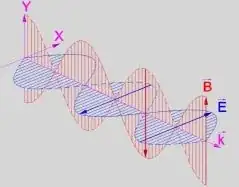How do you visualize an electro-magnetic wave? If there is a very narrow beam (like the one produced by may be a maser?) confined within a few centimeters (in its wave-front) with amplitude say x, what does that mean in terms of its spatial presence?
2 Answers
A simple type of e-m wave is a 'plane wave' in which the $\mathbf {E}$ and $\mathbf B$ vectors are equal right across planes at right angles to the propagation direction, $\hat{\mathbf {z}}$. There is no x or y dependency.
In this simple model the planes are mathematical planes and unbounded; in practice the amplitude of both fields will decrease with distance from the central line of propagation.
You will have seen diagrams of the oscillating $\mathbf {E}$ and $\mathbf B$ vectors at right angles to each other and to the propagation direction. It's important to recognise that the amplitudes of the variations of these vectors aren't measured in distance units, so false conclusions from diagrams can be avoided.
- 37,325
What you get as an EM wave depends on how you generate EM radiation.
The simplest and verifiably measurable wave you get is from a wave generator that accelerates surface electrons back and forth in an antenna rod. From the electric field - which is periodically directed upwards and then again downwards - follows a periodically changing magnetic field around the antenna rod. These two field components propagate in space and can be measured.
But how do both field components leave the antenna emitter? By the well-known phenomenon of the emission of photons by the acceleration process of the electrons. There are zillions of photons leaving the rod and it seems only logical that each of these - demonstrably polarized photons - also has the two field components. And moreover, the magnetic and the electric components are perpendicular to each other and perpendicular to the direction of propagation in a homogeneous environment.

The EM wave near the antenna rod
In all other cases of EM radiation, the radiation is also based on the emission of photons from accelerated or excited electrons, but the photons from thermal processes are neither polarized nor do they oscillate in unison. At the example of the free-electron laser you see that the photons are polarized - after all electrons of high kinetic energy are deflected back and forth between an electric ondulator, thus accelerated, and emit polarized photons. The periodicity of a wave, however, you will not prove.
what does that mean in terms of its spatial presence?
But what you get with the laser are narrowly focused and largely monochromatic light beams. Or better EM rays, because the spectrum ranges from infrared to X-rays.
- 10,980